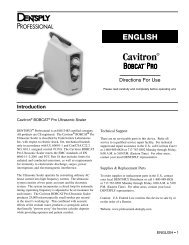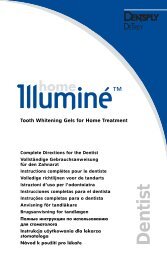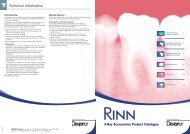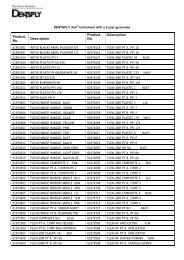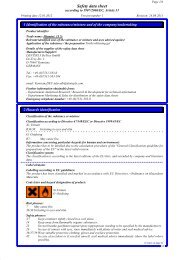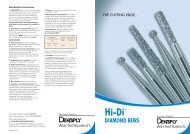Long-term release of monomers from modern dental ... - Dentsply
Long-term release of monomers from modern dental ... - Dentsply
Long-term release of monomers from modern dental ... - Dentsply
You also want an ePaper? Increase the reach of your titles
YUMPU automatically turns print PDFs into web optimized ePapers that Google loves.
Monomer <strong>release</strong> <strong>from</strong> composite materials 71<br />
Table 3<br />
Identification masses <strong>of</strong> <strong>monomers</strong> in liquid chromatography<br />
tandem mass spectrometry (LC–MS/MS)<br />
Substances Qualification Quantification<br />
BisGMA 512 495<br />
TEGDMA 287 113<br />
UDMA 1 499 499<br />
UDMA 2 471 471<br />
Bisphenol A 227 227<br />
BisGMA, bisphenol A glycidyl methacrylate; TEGDMA,<br />
triethylene glycol dimethacrylate; UDMA, urethane dimethacrylate.<br />
Results<br />
The logarithmic values and the standard deviations <strong>of</strong><br />
the substances <strong>release</strong>d <strong>from</strong> the three composite materials,<br />
for each curing time and storage period, are given<br />
in Tables 4–6.<br />
All <strong>monomers</strong> used as reference standards could be<br />
identified in the ethanol samples <strong>of</strong> the composite<br />
materials. However, differences were found in the type <strong>of</strong><br />
<strong>monomers</strong> <strong>release</strong>d <strong>from</strong> each material. BisGMA,<br />
TEGDMA, BPA, and one form <strong>of</strong> UDMA (UDMA 2)<br />
could be detected in the ethanol samples <strong>of</strong> Filtek<br />
Supreme XT. BisGMA, TEGDMA, and Bisphenol A<br />
were <strong>release</strong>d <strong>from</strong> Ceram X; and only BisGMA and<br />
TEGDMA were detected <strong>from</strong> samples <strong>of</strong> Clearfil Core.<br />
The amount <strong>of</strong> BisGMA eluted was always significantly<br />
higher (P < 0.0001) than the amount <strong>of</strong> TEG-<br />
DMA eluted, regardless <strong>of</strong> curing time, type <strong>of</strong> material,<br />
and storage period. According to the statistical analysis<br />
there was a significant difference between the two lightcured<br />
resin composites (P < 0.0001). More BisGMA<br />
and TEGDMA were <strong>release</strong>d <strong>from</strong> Filtek Supreme XT<br />
compared with Ceram X for each storage time tested.<br />
For these two <strong>monomers</strong>, the following results were<br />
obtained.<br />
For Filtek Supreme XT, the curing time had a significant<br />
effect on the elution <strong>of</strong> <strong>monomers</strong> (P < 0.0001). A<br />
smaller amount <strong>of</strong> <strong>monomers</strong> was <strong>release</strong>d after<br />
increasing the polymerization time. However, a curing<br />
time <strong>of</strong> 80 s did not seem to reduce the elution <strong>of</strong><br />
<strong>monomers</strong> compared with a curing time <strong>of</strong> 40 s. The<br />
elution <strong>of</strong> <strong>monomers</strong> differed significantly during the<br />
storage periods (24 h until 1 yr) (P < 0.0001). During<br />
storage, the <strong>release</strong> <strong>of</strong> TEGDMA decreased significantly,<br />
whereas the amount <strong>of</strong> BisGMA <strong>release</strong>d <strong>from</strong> the<br />
polymerized samples remained high, even 1 yr after<br />
curing.<br />
For Ceram X, the curing time exerted a significant<br />
effect on the elution <strong>of</strong> BisGMA and TEGDMA<br />
(P = 0.0004). Curing for 80 s resulted in the <strong>release</strong> <strong>of</strong> a<br />
significantly higher amount <strong>of</strong> <strong>monomers</strong>. The amount<br />
<strong>of</strong> BisGMA and TEGDMA <strong>release</strong>d <strong>from</strong> Ceram X was<br />
significantly influenced by the storage time <strong>of</strong> the composite<br />
samples (P = 0.01). However, the effect <strong>of</strong> the<br />
storage time was significantly different for the two<br />
Table 4<br />
Filtek Supreme XT: log values <strong>of</strong> the concentration ± standard deviation (SD)<br />
24 h 7 d 28 d 1 yr<br />
0s<br />
BisGMA 3.52 ± 0.03 2.22 ± 0.1 1.94 ± 0.26 1.13 ± 0.14<br />
TEGDMA 2.7 ± 0.025 2.67 ± 0.08 1.12 ± 0.54 0.48 ± 0.15<br />
UDMA 1 ND ND ND ND<br />
UDMA 2 2.14 ± 0.03 1.64 ± 0.03 0.7 ± 0.35 1.07 ± 0.18<br />
Bisphenol A ND ND ND<br />
20 s<br />
BisGMA 2.01 ± 0.14 1.59 ± 0.1 1.59 ± 0.07 1.95 ± 0.07<br />
TEGDMA 1.4 ± 0.25 1.16 ± 0.42 0.75 ± 0.05 0.59 ± 0.07<br />
UDMA 1 ND ND ND ND<br />
UDMA 2 1.3 ± 0.08 0.65 ± 0.06 0.67 ± 0.06 2.16 ± 0.04<br />
Bisphenol A ND ND ND ND<br />
40 s<br />
BisGMA 1.82 ± 0.06 1.36 ± 0.11 1.43 ± 0.08 1.9 ± 0.06<br />
TEGDMA 1.16 ± 0.42 1.21 ± 0.07 0.66 ± 0.03 0.55 ± 0.09<br />
UDMA 1 ND ND ND ND<br />
UDMA 2 1.14 ± 0.06 0.44 ± 0.1 0.54 ± 0.05 2.12 ± 0.08<br />
Bisphenol A ND ND ND ND<br />
80 s<br />
BisGMA 1.76 ± 0.06 1.22 ± 0.09 1.16 ± 0.3 1.69 ± 0.28<br />
TEGDMA 1.1 ± 0.11 1.07 ± 0.13 0.55 ± 0.19 0.41 ± 0.18<br />
UDMA 1 ND ND ND ND<br />
UDMA 2 1.04 ± 0.06 0.29 ± 0.09 0.36 ± 0.02 1.84 ± 0.47<br />
Bisphenol A ND ND ND ND<br />
Logarithmic (log) values <strong>of</strong> the concentration and SDs <strong>of</strong> the <strong>monomers</strong> <strong>release</strong>d <strong>from</strong> Filtek Supreme XT.<br />
BisGMA, bisphenol A glycidyl methacrylate; ND, not detected; TEGDMA, triethylene glycol dimethacrylate; UDMA, urethane<br />
dimethacrylate.



